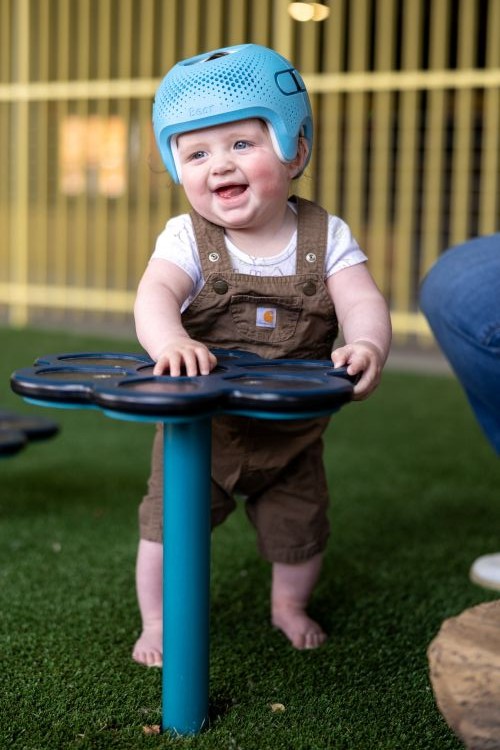Clinical Outcomes and Family Perspectives on the Talee CRO at Gillette Children’s
Since the introduction of the Talee cranial remolding orthosis (CRO) at Gillette Children’s in early summer 2025, both clinical teams and families have reported positive outcomes in the treatment of positional cranial deformities. The Talee helmet, a two-stage, 3D-printed orthosis, is designed to address conditions such as plagiocephaly and brachycephaly with enhanced precision and comfort.
Clinical advantages of the Talee CRO
The Orthotics, Prosthetics, and Seating (OPS) team at Gillette reports the Talee CRO delivers outcomes comparable to the previously used CranioCap, with several notable improvements. The Talee’s dual-stage design allows for more refined control over cranial growth trajectories. Its lightweight, breathable materials improve patient comfort and reduce the incidence of skin irritation and sweating, which are common concerns in long-term orthotic wear.
A key innovation is the integration of a proprietary smartphone app and clinical software that enables caregivers to monitor cranial shape changes over time. This digital interface enhances transparency and engagement, allowing families to visualize progress and remain active participants in the treatment process.
Case study: Early detection and intervention
Katie Thunder, mother of 8-month-old Addison Joan (AJ), noticed limited cervical rotation in her daughter at just 2 weeks of age. AJ was subsequently diagnosed with congenital muscular torticollis, a condition characterized by unilateral shortening of the sternocleidomastoid muscle. Following physical therapy, AJ’s range of motion improved, but persistent occipital flattening prompted a referral to Gillette Children’s at 4 months of age.
AJ was diagnosed with positional plagiocephaly, a condition frequently associated with torticollis due to asymmetric pressure on the head. She was fitted with a Talee helmet, which she wore for 23 hours daily. After consistent use and follow-up care, AJ’s cranial measurements normalized, and she successfully graduated from helmet therapy.
Multidisciplinary expertise in craniofacial care
Gillette Children’s is recognized for its comprehensive approach to craniofacial conditions, emphasizing nonsurgical interventions when appropriate. The OPS team plays a central role in this model, collaborating closely with craniofacial specialists to design and fit orthoses tailored to each patient’s anatomy and clinical needs.
Patients are routinely monitored through follow-up appointments every few weeks, during which orthotists assess cranial growth using 3D scanning technology and make necessary adjustments to the orthosis. This process helps to ensure optimal outcomes for children.

AJ wearing the Talee Cranial Remodeling Helmet
Family-centered care and clinical education
Kathryn Cooley, mother of three sons, including twin boys, sought care at Gillette for her son Thomas after noticing asymmetry in his head shape. She and her husband were impressed by the clinical environment and the professionalism of the OPS team. Clinical educator Jenna Jasken provided detailed explanations throughout the fitting process, helping the family understand the rationale behind each step.
Thomas, like AJ, wears his Talee helmet 23 hours a day. His family has observed significant improvement in his cranial symmetry, and they report high satisfaction with both the device and their care experience.
Scalable, accessible care across the region
Gillette offers head shape evaluations and follow-up appointments at multiple locations across Minnesota, including clinics in St. Paul, Burnsville, Maple Grove, and several regional sites. This distributed care model helps minimize travel burdens for families while maintaining continuity of care.
As technology continues to evolve, Gillette remains committed to delivering accessible, evidence-based care for infants with cranial shape concerns.
Gillette is committed to accessible, evidence-based care
The Talee CRO represents a significant advancement in the nonsurgical management of cranial deformities. Its design, combined with Gillette Children’s multidisciplinary expertise and patient-centered approach, supports excellent clinical outcomes and high family satisfaction. As technology continues to evolve, Gillette remains committed to delivering accessible, evidence-based care for infants with cranial shape concerns. The craniofacial and OPS teams at Gillette look forward to forming partnerships with primary care pediatricians to help more children receive the latest care for head shape concerns.
Refer a patient for head shape concerns at gillettechildrens.org/referral.
Join Our Partners in Care Community!
Subscribe to Partners in Care Journal, a newsletter for medical professionals.
Subscribe Today Home Page
Home Page

